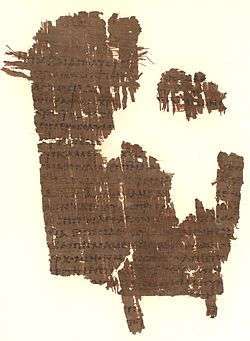Acts 18
| Acts 18 | |
|---|---|
|
Acts 18:27-19:6 on recto side in Papyrus 38, written about AD 250. | |
| Book | Acts of the Apostles |
| Bible part | New Testament |
| Order in the Bible part | 5 |
| Category | Church history |
Acts 18 is the eighteenth chapter of the Acts of the Apostles in the New Testament of the Christian Bible. It records the second missionary journey of Paul, together with Silas and Timothy, and the beginning of the third missionary journey.[1] The book containing this chapter is anonymous, but early Christian tradition uniformly affirmed that Luke composed this book as well as the Gospel of Luke.[2]
Text
The original text is written in Koine Greek and is divided into 28 verses. Some most ancient manuscripts containing this chapter are:
- Papyrus 38 (ca. AD 250)
- Codex Vaticanus (AD 325-350)
- Codex Sinaiticus (AD 330-360)
- Codex Bezae (ca. AD 400)
- Codex Alexandrinus (ca. AD 400-440)
- Codex Laudianus (ca. AD 550)
Places mentioned
This chapter mentions the following places (in order of appearance):
Timeline
This part of the second missionary journey of Paul took place in ca. AD 50-52, based on the time when Gallio was proconsul of Achaia.[3]
Structure
This chapter can be grouped:
- Acts 18:1-17 = Ministering at Corinth
- Acts 18:18-23 = Paul Returns to Antioch
- Acts 18:24-28 = Ministry of Apollos
Verse 1
Paul travelled from Athens to Corinth, a distance of about 82km on modern roads.
Verse 5
- When Silas and Timothy had come from Macedonia, Paul was compelled by the Spirit, and testified to the Jews that Jesus is the Christ.[4]
Verse 12
- When Gallio was proconsul of Achaia, the Jews with one accord rose up against Paul and brought him to the judgment seat,[5]
Lucius Junius Gallio Annaeanus or Gallio was a Roman senator and brother of famous writer Seneca. According to this chapter, he dismissed the charge brought by the Jews against the Apostle Paul. (Acts 18:12-17) His behaviour on this occasion ("but Gallio cared for none of these things", v. 17) showed his disregard for Jewish sensitivities, and also the impartial attitude of Roman officials towards Christianity in its early days. Gallio's tenure can be fairly accurately dated to between 51-52 AD.[6] The reference to proconsul Gallio in the Delphi Inscription, or Gallio Inscription (IG, VII, 1676; SIG, II, 801d; AD 52)[7] provides an important marker for developing a chronology of the life of Apostle Paul by relating it to the trial of Paul in Achaea mentioned in this chapter.[8][9] Therefore, the events of Acts 18 can be dated to this period. This is significant because it is the most accurately known date in the life of Paul.[10]
Verse 18
- So Paul still remained a good while. Then he took leave of the brethren and sailed for Syria, and Priscilla and Aquila were with him. He had his hair cut off at Cenchrea, for he had taken a vow.[11]
See also
References
- ↑ Halley, Henry H. Halley's Bible Handbook: an abbreviated Bible commentary. 23rd edition. Zondervan Publishing House. 1962.
- ↑ Holman Illustrated Bible Handbook. Holman Bible Publishers, Nashville, Tennessee. 2012.
- ↑ John Arthur Thomas Robinson (1919-1983), "Redating the New Testament", Westminster Press, 1976. 369 pages. ISBN ISBN 978-1-57910-527-3
- ↑ Acts 18:5
- ↑ Acts 18:12
- ↑ John Drane,"An Introduction to the Bible",Lion, 1990, p.634-635
- ↑ The Gallio Inscription at http://users.wfu.edu
- ↑ A. Köstenberger, The Cradle, the Cross, and the Crown: An Introduction to the New Testament, 2009 ISBN 978-0-8054-4365-3 page 400
- ↑ The Cambridge Companion to St Paul by James D. G. Dunn (Nov 10, 2003) Cambridge Univ Press ISBN 0521786940 page 20
- ↑ Pauline Chronology: His Life and Missionary Work, from Catholic Resources by Felix Just, S.J.
- ↑ Acts 18:18
